
The beet armyworm or small mottled willow moth is one of the best-known agricultural pest insects. It is also known as the asparagus fern caterpillar. It is native to Asia, but has been introduced worldwide and is now found almost anywhere its many host crops are grown. The voracious larvae are the main culprits. In the British Isles, where it is an introduced species and not known to breed, the adult moth is known as the small mottled willow moth.
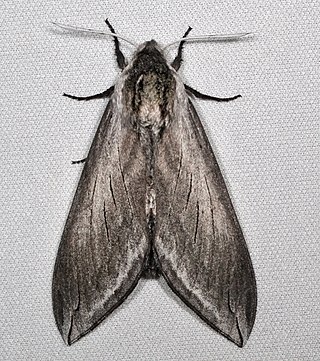
Sphinx perelegans, commonly known as the elegant sphinx, is a species of hawkmoth described by Henry Edwards in 1874. It is a large gray moth native to western North America.

Carcina quercana is a species of moth of the family Depressariidae. It is found in Europe. It has been introduced recently in North America, British Columbia and western Washington. It is occasionally known by several common names including oak lantern, long-horned flat-body, and oak-skeletonizer moth.
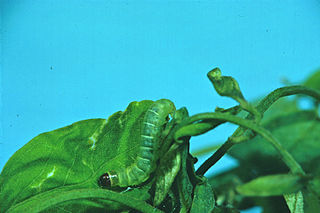
Agonopterix robiniella, the four-dotted agonopterix moth or locust leaf roller, is a moth of the family Depressariidae. It is found in North America, where it has been recorded to appear in places from Nova Scotia to Georgia, west to Oklahoma, north to Illinois, Michigan and southern Ontario.

Batrachedra praeangusta is a moth of the family Batrachedridae which is native to Europe. It is also found in North America. It was first described by Adrian Haworth in 1828 from the type specimen found in England. The foodplants of the larvae are poplars and willows.

Dyseriocrania griseocapitella is a moth of the family Eriocraniidae. It is found from Nova Scotia to Florida, west to Illinois and Mississippi.
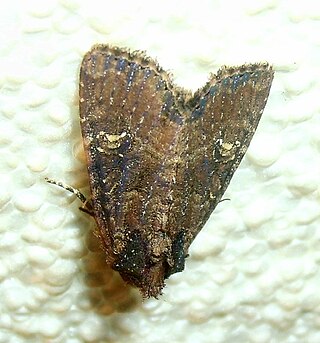
Apamea unanimis, the small clouded brindle, is a moth of the family Noctuidae. The species was first described by Jacob Hübner in 1813. It is native to Europe, Turkey, Azerbaijan, and western Siberia. It has been introduced in North America and can now be found in Ontario, Quebec, New Brunswick, New York, Michigan, and Wisconsin.
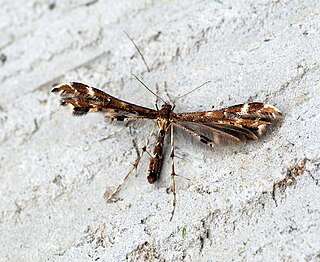
Capperia britanniodactylus, also known as the wood sage plume is a moth of the family Pterophoridae, found in Europe. It was first described by Charles Stuart Gregson in 1869.
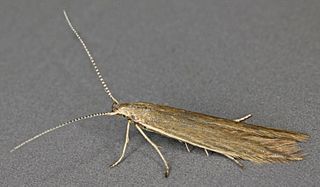
Coleophora alticolella is a moth of the family Coleophoridae, found in Europe and North America.
Capperia fusca is a moth of the family Pterophoridae. It is found in Spain, France, Belgium, Germany, Switzerland, Italy, Austria, Croatia, the Czech Republic, Poland, Slovakia, Hungary, Romania, Bulgaria, North Macedonia, Greece and southern Russia. It is also known from Turkey.
Capperia hellenica is a moth of the family Pterophoridae. It is found in Spain, France, Italy, Croatia, Bosnia and Herzegovina, North Macedonia and Greece. It has also been recorded from Malta and Asia Minor.
Capperia maratonica is a moth of the family Pterophoridae. It is found in Spain, France, Italy, Sardinia, Croatia, Serbia and Montenegro, Bulgaria, Romania, Ukraine, North Macedonia, Greece and Cyprus. It has also been recorded from the Palestinian Territories.
Capperia loranus is a moth of the family Pterophoridae. It is found in Spain, France, Belgium, Germany, Italy, Austria, the Czech Republic and Slovakia.
Capperia evansi is a moth of the family Pterophoridae. It is found in Canada.
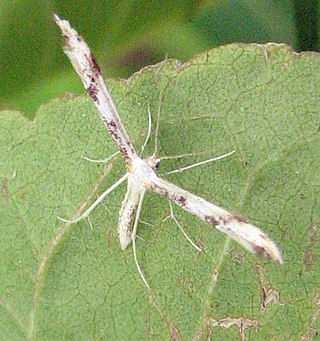
Adaina montanus is a moth of the family Pterophoridae. It is found in North America, including south-eastern Canada and the north-eastern United States.

Agonopterix conterminella is a moth of the family Depressariidae which is found in Asia, Europe and North America. It was described by Philipp Christoph Zeller in 1839 from a specimen found in Augsburg, Germany. The larvae feed on the terminal shoots of willows.
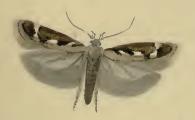
Caryocolum marmorea is a moth of the family Gelechiidae. It is found from Scandinavia to the Mediterranean islands, and from Ireland to Poland, Hungary and Greece. It is also found on the Canary Islands and Madeira. It is also found in North America.

Swammerdamia caesiella is a moth of the family Yponomeutidae. It is found from most of Europe to Japan. It is also present in North America, where it is possibly an introduced species.

Xanthotype sospeta, the crocus geometer, is a species of moth in the family Geometridae. It was first described by Dru Drury in 1773 from Jamaica. It is also found in North America, where it has been recorded from Nova Scotia to southern British Columbia, south to Colorado and Georgia. The habitat consists of deciduous and mixedwood forests.
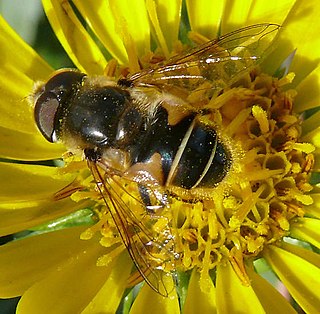
Eristalis hirta, the black-footed drone fly, is a common Western North American species of syrphid fly, first officially described by Loew in 1866. Hoverflies get their names from the ability to remain nearly motionless while in flight. The adults are also known as flower flies as they are commonly found on and around flowers, from which they get both energy-giving nectar and protein-rich pollen. The larvae are aquatic filter-feeders of the rat-tailed type.













